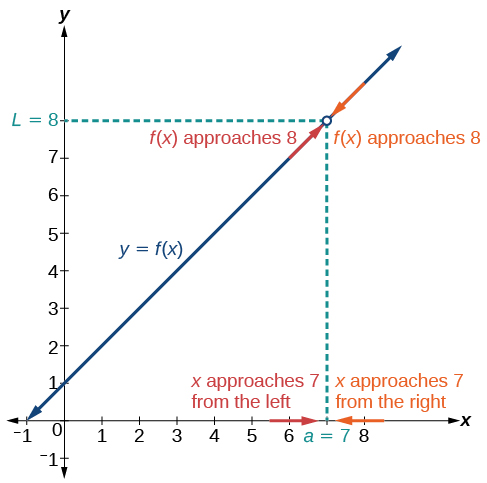| << Chapter < Page | Chapter >> Page > |
A quantity is the limit of a function as approaches if, as the input values of approach (but do not equal the corresponding output values of get closer to Note that the value of the limit is not affected by the output value of at Both and must be real numbers. We write it as
For the following limit, define and
First, we recognize the notation of a limit. If the limit exists, as approaches we write
We are given
This means that
We can approach the input of a function from either side of a value—from the left or the right. [link] shows the values of
as described earlier and depicted in [link] .

Values described as “from the left” are less than the input value 7 and would therefore appear to the left of the value on a number line. The input values that approach 7 from the left in [link] are and The corresponding outputs are and These values are getting closer to 8. The limit of values of as approaches from the left is known as the left-hand limit. For this function, 8 is the left-hand limit of the function as approaches 7.
Values described as “from the right” are greater than the input value 7 and would therefore appear to the right of the value on a number line. The input values that approach 7 from the right in [link] are and The corresponding outputs are and These values are getting closer to 8. The limit of values of as approaches from the right is known as the right-hand limit. For this function, 8 is also the right-hand limit of the function as approaches 7.
[link] shows that we can get the output of the function within a distance of 0.1 from 8 by using an input within a distance of 0.1 from 7. In other words, we need an input within the interval to produce an output value of within the interval
We also see that we can get output values of successively closer to 8 by selecting input values closer to 7. In fact, we can obtain output values within any specified interval if we choose appropriate input values.
[link] provides a visual representation of the left- and right-hand limits of the function. From the graph of we observe the output can get infinitesimally close to as approaches 7 from the left and as approaches 7 from the right.
To indicate the left-hand limit, we write
To indicate the right-hand limit, we write

The left-hand limit of a function as approaches from the left is equal to denoted by
The values of can get as close to the limit as we like by taking values of sufficiently close to such that and
The right-hand limit of a function as approaches from the right, is equal to denoted by
The values of can get as close to the limit as we like by taking values of sufficiently close to but greater than Both and are real numbers.

Notification Switch
Would you like to follow the 'Precalculus' conversation and receive update notifications?